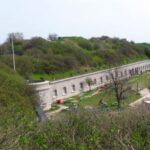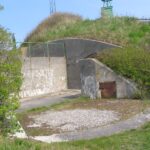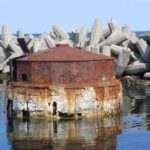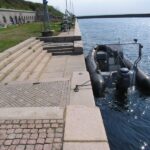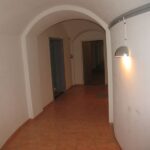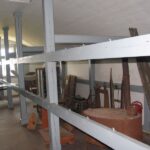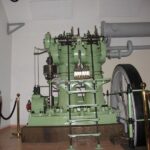The Flak Fort is a sea fort.
It was built during the years 1910 to 1914 in connection with the expansion of Copenhagen sea fortification. It was built on the northwestern part of the Saltholm Flak (Saltholm reef).
The fort id part of the third and farthest part of the sea fortifications. It is built on an artificial island, the world’s second largest artificial island of 32,000 m2.
As far as is known this is the first time, that reinforced concrete lowering boxes have been used as foundation.
The tasks
The task of the fort was to cover the “Dutch Deep” waters, consisting of the canal between the Flak Fort and the Middelgrund Fort. It also had the task to to protect the Flinterenden waters and the waters between Sweden and the island of Saltholm.
Flakfortet also had the opportunity to prevent north-south traffic in the Öresund if neccesary.
The Fort was rearmed
The fort has been rearmed several times.
At the time of the construction it was armed with four 29 cm howitzers M / 1910, six 21 cm cannons M / 1913 and four 75 mm quick-firing cannons.
1914-18 the fort was reinforced with a 75 mm, two 47 mm balloon guns (AA) and two 8 mm. recoilless rifles.
In addition, four 150 cm projectors and one 90 cm projector were set up for use against aircraft. The fort was manned by 550 men.
In 1950, part of this armament was replaced by four heavy German 105 mm. anti-aircraft guns that were probably moved from the position in
Hansted (Hanstholm) and six double 40 mm anti-aircraft guns M / 36 that were received as Marshall aid. 40 mm. the cannon was an American copy of a 40 mm. Bofors cannon. In addition, a smaller number of 20 mm. anti-aircraft guns.
The Battery became SAM launcher Area
The Flak fort was used as a sea fort until 1957.
In 1965, it was decided to establish a HAWK rocket squadron at Middelgrundsfortet, but during the major rebuilding work this required, it was temporarily moved to Flakfortet until 1968.
After this time, the fort was leased to the Copenhagen Sailing Union in 1975 and opened to the public.
During this period, the fort fell victim to extensive vandalism.
The exterior
- The casemate building
- Ornament at the gate
- The commanders residence
- The battery
- Emplacement for 75 mm. gun
- Gun emplacement
- Caponiere in the moat
- The harbour of the fort
The interior
- Officers accommodations
- Accomodations for the ordinary ranks
- Dormitory
- Dormitory for the AA crew
- Decorations in the dormitory
- The stowe
- Elevator for ammuniition
- The generator engine



